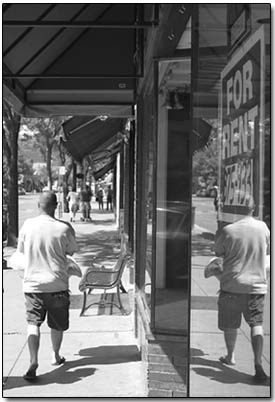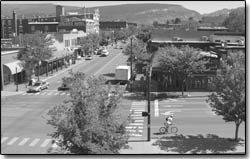 |
A pedestrian passes a “for
rent” sign in an empty storefront on Main Avenue on
Tuesday. As retail sales slump and big-box chain stores
open on the edge of
town, downtown business leaders are devising ways to keep
Main Avenue and Durango’s central business district
healthy./Photo by Todd Newcomer. |
Slumping retail sales, lower sales tax revenues
and the opening of new national chain stores south of town have
business leaders and city officials starting to scheme ideas
to pump new blood into Durango’s central business district.
Business leaders aren’t painting a gloomy picture –
one that depicts Main Avenue as a tourist town gone dry –
but they are beginning to recognize trends that may constrain
the vitality of Durango’s most important attraction. Longtime
Main Avenue businesses, such as Do It Best hardware, are closing
shop, sending locals to South Durango for everyday sundries.
And, increasingly, stores that once drew locals are being replaced
with chic boutiques better suited for tourists.
“It’s an evolution that’s been going on for
some time,” says Bobby Lieb, executive director of La
Plata Economic Dev-elopment Action Partnership.
As this summer tourist season kicks off, there are, according
to real estate listings, at least 10 businesses for sale within
the central business district. There also are empty storefronts
up and down Main.
“The fact that there are vacancies now this early in
the summer is an indication of a troubled economy,” Lieb
says.
Cuatro Bernard, owner of Durango Fly Goods, is selling his
fly shop because he’s moving to Australia. Bernard says
his business was down 30 percent last year due to the Missionary
Ridge Fire, but he still has a profitable company. He admits
that if he’d attempted to sell his shop two years ago,
he would have more prospective buyers, but he recognizes the
changing local and national economy and its impact on small-business
owners is beyond control.
A year ago, Antoinette Carr bought the former San Juan Room
and turned it into the Wild Horse Saloon. Now, she’s selling
the business because of health reasons. She says that last year’s
fire negatively impacted her revenue, though she, too, still
has a profitable company that she believes will flourish.
“I expect a busy summer, and to even do better this year,”
Carr says. “People still are coming downtown. It’s
still alive.”
But in spite of profits, business and city leaders say they
can’t overlook important signs that the business district
is developing – for good or bad – a new face. And
the future will require more than trying to retain businesses
that draw tourists.
“The central business district can’t go head to
head with South Durango just by changing the types of stores,”
Lieb says.
The key, many say, is appealing to locals and ensuring that
they make Main Avenue a frequent destination for all sorts of
reasons. To respond to the changes, LEAD, the city and other
business organizations are working to implement policies to
encourage growth downtown. Lieb says that one way to keep this
area alive is to combine commercial and residential growth.
The city should allow for residential units above street-level
businesses, which helps keep residents downtown. This would
mean, however, possibly changing the city’s parking requirements.
Currently, the city requires developers to provide one parking
space for about every 300 square feet of additional space. If
space isn’t available, developers must pay the city an
in-lieu fee of $6,000 for each space.
“In my opinion, this is hindering downtown development,”
Lieb says.
 |
A view of a slow day for the Durango Central
Business District from the intersection of Main and
College./Photo by Todd Newcomer. |
This adds to the existing parking woes Durangoans have faced
for years. City officials routinely hear complaints from locals
that there is a lack of parking availability, says Durango Mayor
Virginia Castro. She says she shares their concerns and believes
the city needs to address them immediately to maintain the business
district’s vitality. Castro says that the City Council
has asked city staffers to determine the cost of returning to
providing free trolley service. The question is, she says, if
people will use it.
“Since these days you can buy almost everything on the
Internet, it is now more important than ever that we do whatever
we can to encourage people to shop downtown,” she says.
Castro says the city is also continuing its search for an events
coordinator. Earlier this year the city started looking for
a person to promote and organize events downtown and to be a
liaison between the city and downtown businesses. The initial
search fell dead, but Assistant City Manager Greg Caton says
the city is moving forward with a new proposal.
“We’re taking a fresh look at how to accomplish
those duties and responsibilities,” says Caton. Instead
of a contracted position, Caton says the coordinator may be
a city employee – on the city payroll with benefits.
Meanwhile, the city continues to work with LEAD and others
to outline additional options. Among their top concerns is that
La Plata County conduct a feasibility study to move its courts
and legal offices to a new building in Bodo Park. Wayne Bedor,
La Plata County finance director, says the idea is “strictly
a plan” that may not come to fruition. He adds that it’s
necessary for the county to explore the new justice center because
the County Courthouse is overcrowded, with many of employees
now working from offices in the Old Main Post Office building.
But because the county is one of Durango’s largest employers,
many fear that moving these offices out of downtown seriously
threatens its viability. Lieb says that lawyers and title companies
may follow suit, because they routinely use the court offices.
“These are symbiotically connected businesses, and they
may move to be closer to the courts,” he explains.
Patty Burkholder, president of Wells Fargo Bank, agrees that
it’s imperative to keep county offices downtown. Twelve
years ago, Burkholder was living in Greeley when the town’s
central business district suffered tremendous losses. After
the city closed off streets to create a pedestrian mall, many
locals stopped shopping at stores because parking spaces were
sparse or too far away. Additionally, businesses lacked visibility
to passersby. Locals began shopping at a new mall built on the
edge of town, and many businesses ended up moving there as well.
Burkholder said that the mainstays in downtown Greeley were
county offices. Although she doesn’t see glaring similarities
between Greeley and Durango, she knows firsthand how important
it is for cities to make wise choices to retain local traffic
on Main Avenues. So far, she says, she still sees people in
Durango head downtown during lunch hours to do errands or eat.
But she says she also realizes that as the central business
district evolves and businesses pop up on the outskirts of town,
city and business leaders face significant challenges to stave
off stagnancy.
“It’s a lot easier to keep what you’ve got
than to have to build it back,” Burkholder says.
Lieb agrees, but adds that there’s no sense of urgency
yet. He says he wants to reserve a complete reaction for the
end of this summer, when retail sales and tax revenues will
provide a clearer picture. Until then, LEAD advocates that the
city continue to study density and parking issues while downtown
is still alive and kicking.
“It’s a place people still go. It hasn’t
been abandoned,” Lieb says. “But we can’t
rest on our laurels that it will always remain viable if we
don’t do anything.”

